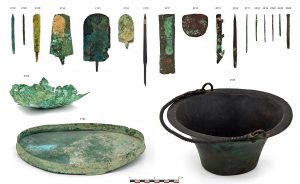A metal vessel deposited in a tomb at the Egyptian site Abusir 5,000 years ago was made of a material that was used concurrently in the distant Anatolia (present-day Turkey). The article “Invisible connections. Early Dynastic and Old Kingdom Egyptian metalwork in the Egyptian Museum of Leipzig University” published in the Journal of Archaeological Science shows how far metals travelled in the third millennium BC.
The paper contains an in-depth analysis of 22 ancient Egyptian artefacts currently stored in the Egyptian Museum of Leipzig University (Germany) (Fig. 1). The analytical work performed by Czech scholars deepens our understanding of the use of copper in the Early Dynastic Period and the Old Kingdom. The 3rd millennium BC Egyptian copper metallurgy has been known only superficially until now.
The artefacts were found at the Egyptian sites of Abusir, Abydos and Giza. They were excavated in the royal tomb of King Khasekhemwy at Abydos (c. 2700 BCE) and in non-royal tombs of officials from the Early Dynastic Period (Abusir; c. 3100–2900 BCE) and the Old Kingdom (Giza; c. 2350–2275 BCE).
The paper is innovative in the range of analyses used and in combining them with Egyptological and archaeological information. The production methods were similar for all artefacts, which were hammered and annealed to their final shapes. They were made either from copper with minor impurities of other elements or from arsenical copper, the most frequently used alloy in the ancient Near East in the third millennium BC. As lead was present in minute traces in all the artefacts, lead isotope analysis has been used to indicate the origin of the ores.
As the title suggests, the analyses have revealed “invisible connections” between the regions where the ore was mined and those where the artefacts were deposited. “Lead isotopes showed us where the ore was most probably coming from,” says the first author of the study, archaeometallurgist Jiří Kmošek. “And the results were quite unexpected,” adds a corresponding author, Egyptologist Martin Odler.
The ore coming from the Sinai Peninsula has been expected and confirmed, as it was the most frequent target of ancient Egyptian expeditions with many ancient Egyptian mining expedition inscriptions. Not at all negligible amount of ore originated from the Eastern Desert of Egypt. There are not many inscriptions in that area, but archaeological research in the last two decades has identified many mining sites, and analyses have now confirmed that the ore was indeed used by ancient Egyptians.
The greatest surprise was a large bowl from a Dynasty-1 tomb at Abusir (Fig. 2). It is peculiar by its contents of arsenic (1.4%) and nickel (4.8%), very unusual for that period in Egypt. The lead isotope ratios match Anatolian ores and are similar to contemporary Early Bronze Age Anatolian artefacts, in a distance more than 1,500 kilometres.
The vessel was most probably made in Egypt, but the ore or metal ingot must have travelled from far away. Although this is most probably not an evidence of direct contact between the two regions, special metals had circulated around ancient Near East earlier than previously thought.
The project will continue with the evaluation and publication of data from another important corpus stored in Leipzig: bronze artefacts from the Second Intermediate Period and the New Kingdom site Aniba in Nubia.
The authors of the article are archaeometallurgist Jiří Kmošek from the Department of Chemical Technology, Faculty of Restoration, University of Pardubice; Egyptologist Martin Odler from the Czech Institute of Egyptology, Faculty of Arts, Charles University, Prague; and two physicists, Marek Fikrle from the Nuclear Physics Institute, Academy of Sciences of the Czech Republic and Yulia V. Kochergina from the Czech Geological Survey.
Figure 1: The analysed assemblage of artefacts from the Egyptian Museum of Leipzig University (photo by Jiří Kmošek).
Figure 2: The Dynasty-1 bowl from Abusir (ÄMUL 2162; photo by Jiří Kmošek).
Petr Kukal, spokesperson, Faculty of Arts







